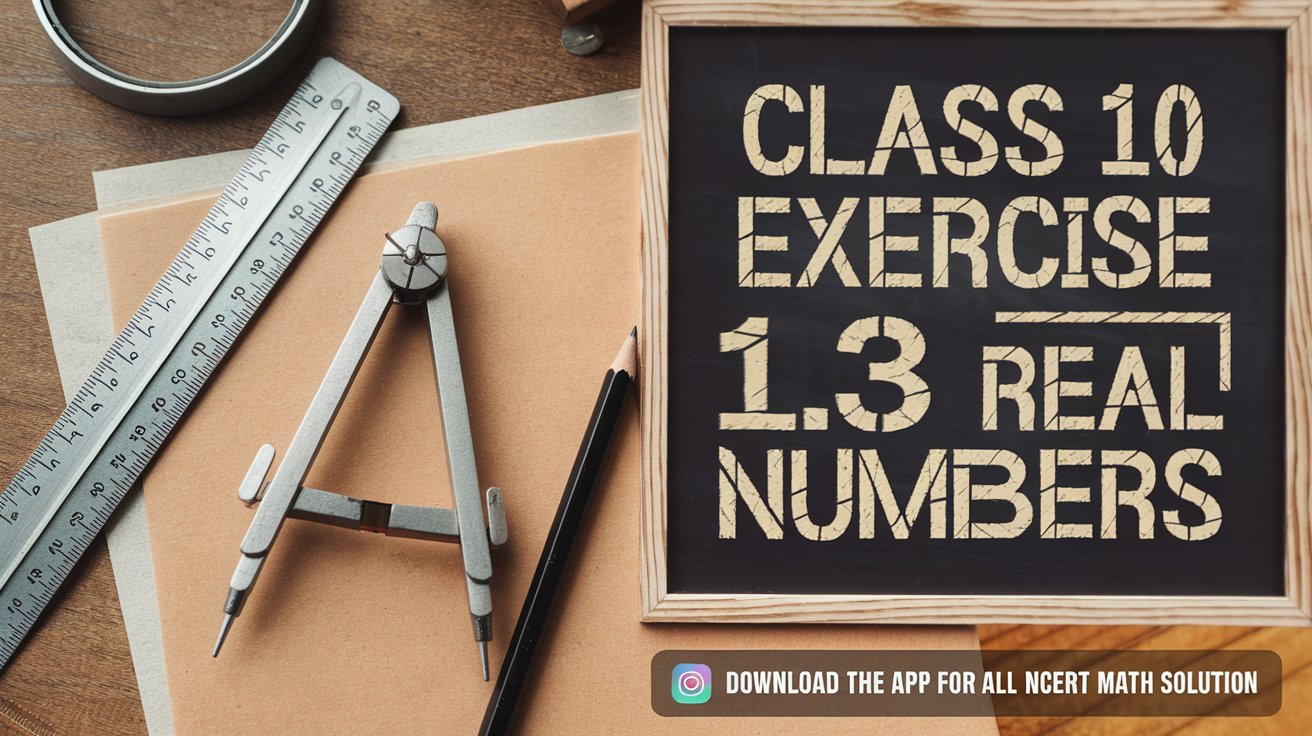NCERT Solutions for Class 10 Maths Chapter 1 Exercise 1.3 || CBSE Class 10 maths chapter 1 Ex 1.3
Get the complete NCERT Solutions for Class 10 Maths Chapter 1: Real Numbers, covering Exercise 1.3. This free resource helps you understand key concepts and solve problems with ease, perfect for CBSE Class 10 students preparing for exams using NCERT Maths materials. We hope the NCERT Solutions for Class 10 Maths Chapter 1 Real Numbers Exercise 1.3 help you. If you have any queries regarding NCERT Maths Solutions Chapter 1 Real Numbers Exercise 1.3, drop a comment below, and we will get back to you at the earliest. NCERT Class 10 Mathematics Chapter 1: Complete Resource for Real Numbers – For Free.

NCERT Solutions for Class 10 Maths Chapter 1 Exercise 1.3 || CBSE Class 10 maths chapter 1 Ex 1.3
Exercise-1.3
NCERT Solutions for Class 10 Maths Chapter 1 Exercise 1.3 || CBSE Class 10 maths chapter 1 Ex 1.3
Download the Math Ninja App Now1. Prove that \( \sqrt{5 } \) is irrational.
Answer
Let's assume that \( \sqrt{5 } \) is a rational number.Hence, \( \sqrt{ 5} \) can be written in the form \( \frac{a }{ b} \) [where \( a \) and \( b(b \neq 0) \) are co-prime (i.e. no common factor other than 1)]
\(\therefore \sqrt{5 } =\frac{\mathrm{a} }{ \mathrm{b}}\)
\(\Rightarrow \sqrt{ 5} \mathrm{~b}=\mathrm{a}\)
Squaring both sides,
\(\Rightarrow(\sqrt{ 5} b)^{2}=a^{2}\)
\(\Rightarrow 5 b^{2}=a^{2}\)
\(\Rightarrow \frac{a^{2} }{ 5}=b^{2}\)
Hence, 5 divides \( \mathrm{a}^{2} \)
By theorem, if p is a prime number and p divides \( \mathrm{a}^{2} \), then p divides a, where \( a \) is a positive number
So, 5 divides a too
Hence, we can say \( \frac{\mathrm{a} }{ 5}=\mathrm{c} \) where, c is some integer
So, \( \mathrm{a}=5 \mathrm{c} \)
Now we know that,
\(5 b^{2}=a^{2}\)
Putting \( \mathrm{a}=5 \mathrm{c} \),
\(\Rightarrow 5 b^{2}=(5 c)^{2}\)
\(\Rightarrow 5 b^{2}=25 c^{2}\)
\(\Rightarrow b^{2}=5 c^{2}\)
\(\therefore \frac{\mathrm{b}^{2} }{ 5}=\mathrm{c}^{2}\)
Hence, 5 divides \( \mathrm{b}^{2} \)
By theorem, if p is a prime number and p divides \( \mathrm{a}^{2} \), then p divides a, where a is a positive number
So, 5 divides b too
By earlier deductions, 5 divides both a and b
Hence, 5 is a factor of \( a \) and \( b \)
\( \therefore \mathrm{a} \) and b are not co-prime.
Hence, the assumption is wrong.
\( \therefore \) By contradiction,
\( \therefore \sqrt{5} \) is irrational
2. Prove that \( 3+2 \sqrt{5 } \) is irrational.
Answer
To Prove: \( 3+2 \sqrt{5 } \) is irrationalProof: Let \( 3+2 \sqrt{5} \) is rational
A number is said to be rational if it can be expressed in the form \( \frac{\mathrm{p} }{ \mathrm{q}} \) where \( q \neq 0 \)
Therefore,
We can find two integers \( p \ \& \ q \) where, \( (q \neq 0) \) such that
\(3+2 \sqrt{5}=\frac{p}{q}\)
\(2 \sqrt{5}=\frac{p}{q}-3\)
Since p and q are integers, \( \frac{1}{2}\left(\frac{p}{q}-3\right) \) will also be rational and therefore, \( \sqrt{5} \) is rational.
We know that \( \sqrt{5 } \) is irrational but according to above statement it has to be rational
So, both the comments are contradictory, Hence, the number should have been irrational to make the statement correct.
Therefore, \( 3+2 \sqrt{5} \) is irrational.
NCERT Solutions for Class 10 Maths Chapter 1 Exercise 1.3 || CBSE Class 10 maths chapter 1 Ex 1.3
Download the Math Ninja App Now
3.
(i) Prove that the following are irrationals: \( \frac{1}{\sqrt{2}} \)
Answer
Let \( \frac{1}{\sqrt{2}} \) is rationalTherefore, we can find two integers \( p \ \& \ q \) where, \( q \neq 0 \) such that
\( \frac{1}{\sqrt{2}}=\frac{p}{q} \)
\( \sqrt{2}=\frac{q}{p} \)
\( \frac{q}{p} \) is rational as p and q are integers.
Therefore, \( \sqrt{2} \) is rational which contradicts to the fact that \( \sqrt{2} \) is irrational.
Hence, our assumption is false and \( \frac{1}{\sqrt{2}} \) is irrational.
(ii) Prove that the following are irrationals: \( 7 \sqrt{5} \)
Answer
Let is rational.Therefore, we can find two integers \( \mathrm{p} \ \& \ \mathrm{q} \) where, \( \mathrm{q} \neq 0 \) such that \( 7 \sqrt{5}=\frac{p}{q} \) for some integers p and q
\( \therefore \sqrt{5}=\frac{p}{7 q} \)
\( \frac{p}{7 q} \) is rational as p and q are integers.
Therefore, \( \sqrt{5} \) should be rational.
This contradicts the fact that \( \sqrt{5} \) is irrational.
Therefore our assumption that is rational is false.
Hence, \( 7 \sqrt{5} \) is irrational.
(iii) Prove that the following are irrationals: \( 6+\sqrt{2} \)
Answer
Let be \( 6+\sqrt{2} \) rational.Therefore, we can find two integers \( \mathrm{p} \ \& \ \mathrm{q} \) where \( \mathrm{q} \neq 0 \), such that
\( 6+\sqrt{2}=\frac{p}{q} \)
\( \sqrt{2}=\frac{p}{q}-6 \)
Since p and q are integers, \( \frac{p}{q}-6 \) is also rational
Hence, \( \sqrt{2} \) should be rational, this contradicts the fact that is irrational.
So, our assumption is false and hence, \( 6+\sqrt{2} \) is irrational.
Since \( p \) and \( q \) are integers, \( 6+\sqrt{2} \) is also rational.
NCERT Solutions for Class 10 Maths Chapter 1 Exercise 1.3 || CBSE Class 10 maths chapter 1 Ex 1.3
Download the Math Ninja App Now
Central Board of Secondary Education Official Site
Class 10 : NCERT Solutions for Class 10 Maths Chapter 1 Exercise 1.1
Class 10 : NCERT Solutions for Class 10 Maths Chapter 1 Exercise 1.2
Class 10 : CBSE Class 10 Maths Chapter 2 Polynomials Ex 2.1 || NCERT Solutions for Class 10 Maths Chapter 2: Polynomials (English Medium)
Class 10 : CBSE Class 10 Maths Chapter 10 Circles solutions Ex 10.2
Class 10 : CBSE Class 10 Maths Chapter 13 Surface Areas and Volumes solutions Ex 13.2
Class 10 : CBSE Class 10 Maths Chapter 13 Surface Areas and Volumes solutions Ex 13.3
Class 10 : NCERT Solutions for Class 10 Maths Chapter 1 Exercise 1.1
Class 10 : NCERT Solutions for Class 10 Maths Chapter 1 Exercise 1.2
Class 10 : CBSE Class 10 Maths Chapter 2 Polynomials Ex 2.1 || NCERT Solutions for Class 10 Maths Chapter 2: Polynomials (English Medium)
Class 10 : CBSE Class 10 Maths Chapter 10 Circles solutions Ex 10.2
Class 10 : CBSE Class 10 Maths Chapter 13 Surface Areas and Volumes solutions Ex 13.2
Class 10 : CBSE Class 10 Maths Chapter 13 Surface Areas and Volumes solutions Ex 13.3
